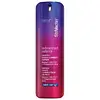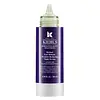What's inside
What's inside
 Key Ingredients
Key Ingredients

 Benefits
Benefits

 Concerns
Concerns

 Ingredients Side-by-side
Ingredients Side-by-side

Water
Skin ConditioningTriheptanoin
Skin ConditioningPropanediol
SolventMyristyl Nicotinate
Skin ConditioningDicaprylyl Ether
EmollientCoconut Alkanes
EmollientSqualane
EmollientDimethicone
Emollient1,2-Hexanediol
Skin ConditioningEctoin
Skin ConditioningBis-Stearyl Dimethicone
EmollientRetinol
Skin ConditioningWithania Somnifera Root Extract
Skin ConditioningPolyglutamic Acid
Skin ConditioningMorus Alba Leaf Extract
Skin ConditioningOryza Sativa Bran Extract
Skin ConditioningRosmarinus Officinalis Leaf Extract
AntimicrobialSodium Hyaluronate
HumectantChondrus Crispus Extract
Skin ConditioningCarthamus Tinctorius Seed Oil
MaskingHelianthus Annuus Seed Oil
EmollientBacillus/Sea Salt Ferment Filtrate
Skin ConditioningHelianthus Annuus Extract
EmollientButyrospermum Parkii Butter
Skin ConditioningGlycerin
HumectantCucumis Sativus Seed Extract
Skin ConditioningBeta-Glucan
Skin ConditioningHordeum Vulgare Extract
EmollientBehenyl Alcohol
EmollientGlyceryl Behenate
EmollientBisabolol
MaskingLecithin
EmollientTocopheryl Acetate
AntioxidantZingiber Officinale Root Extract
MaskingPentylene Glycol
Skin ConditioningCaprylyl Glycol
EmollientPolysorbate 20
EmulsifyingPhytosterols
Skin ConditioningPolysilicone-11
Coco-Caprylate/Caprate
EmollientMethyl Methacrylate/Glycol Dimethacrylate Crosspolymer
Tocopherol
AntioxidantPolyisobutene
Caprylyl/Capryl Glucoside
CleansingAcrylates/C10-30 Alkyl Acrylate Crosspolymer
Emulsion StabilisingSynthetic Fluorphlogopite
Hydroxyacetophenone
AntioxidantSodium Acrylate/Sodium Acryloyldimethyl Taurate Copolymer
Emulsion StabilisingSorbitan Oleate
EmulsifyingXanthan Gum
EmulsifyingDisodium EDTA
Propyl Gallate
AntioxidantCaprylhydroxamic Acid
Aminomethyl Propanol
BufferingSilica
AbrasiveAscorbic Acid
AntioxidantParfum
MaskingBHT
AntioxidantCitric Acid
BufferingTin Oxide
AbrasiveAlpha-Isomethyl Ionone
PerfumingCI 77891
Cosmetic ColorantWater, Triheptanoin, Propanediol, Myristyl Nicotinate, Dicaprylyl Ether, Coconut Alkanes, Squalane, Dimethicone, 1,2-Hexanediol, Ectoin, Bis-Stearyl Dimethicone, Retinol, Withania Somnifera Root Extract, Polyglutamic Acid, Morus Alba Leaf Extract, Oryza Sativa Bran Extract, Rosmarinus Officinalis Leaf Extract, Sodium Hyaluronate, Chondrus Crispus Extract, Carthamus Tinctorius Seed Oil, Helianthus Annuus Seed Oil, Bacillus/Sea Salt Ferment Filtrate, Helianthus Annuus Extract, Butyrospermum Parkii Butter, Glycerin, Cucumis Sativus Seed Extract, Beta-Glucan, Hordeum Vulgare Extract, Behenyl Alcohol, Glyceryl Behenate, Bisabolol, Lecithin, Tocopheryl Acetate, Zingiber Officinale Root Extract, Pentylene Glycol, Caprylyl Glycol, Polysorbate 20, Phytosterols, Polysilicone-11, Coco-Caprylate/Caprate, Methyl Methacrylate/Glycol Dimethacrylate Crosspolymer, Tocopherol, Polyisobutene, Caprylyl/Capryl Glucoside, Acrylates/C10-30 Alkyl Acrylate Crosspolymer, Synthetic Fluorphlogopite, Hydroxyacetophenone, Sodium Acrylate/Sodium Acryloyldimethyl Taurate Copolymer, Sorbitan Oleate, Xanthan Gum, Disodium EDTA, Propyl Gallate, Caprylhydroxamic Acid, Aminomethyl Propanol, Silica, Ascorbic Acid, Parfum, BHT, Citric Acid, Tin Oxide, Alpha-Isomethyl Ionone, CI 77891
Water
Skin ConditioningGlycerin
HumectantPropanediol
SolventButylene Glycol
HumectantGlycereth-26
HumectantPanthenol
Skin Conditioning1,2-Hexanediol
Skin ConditioningPolyglycerin-3
HumectantC12-14 Pareth-12
EmulsifyingPhenoxyethanol
PreservativeCaprylyl Glycol
EmollientAmmonium Acryloyldimethyltaurate/Vp Copolymer
Betaine
HumectantXanthan Gum
EmulsifyingEthylhexylglycerin
Skin ConditioningAdenosine
Skin ConditioningCarbomer
Emulsion StabilisingGlyceryl Acrylate/Acrylic Acid Copolymer
HumectantTromethamine
BufferingGlycereth-25 PCA Isostearate
EmulsifyingT-Butyl Alcohol
PerfumingTocopherol
AntioxidantWater, Glycerin, Propanediol, Butylene Glycol, Glycereth-26, Panthenol, 1,2-Hexanediol, Polyglycerin-3, C12-14 Pareth-12, Phenoxyethanol, Caprylyl Glycol, Ammonium Acryloyldimethyltaurate/Vp Copolymer, Betaine, Xanthan Gum, Ethylhexylglycerin, Adenosine, Carbomer, Glyceryl Acrylate/Acrylic Acid Copolymer, Tromethamine, Glycereth-25 PCA Isostearate, T-Butyl Alcohol, Tocopherol
Ingredients Explained
These ingredients are found in both products.
Ingredients higher up in an ingredient list are typically present in a larger amount.
1,2-Hexanediol is a synthetic liquid and another multi-functional powerhouse.
It is a:
- Humectant, drawing moisture into the skin
- Emollient, helping to soften skin
- Solvent, dispersing and stabilizing formulas
- Preservative booster, enhancing the antimicrobial activity of other preservatives
Caprylyl Glycol is a humectant and emollient, meaning it attracts and preserves moisture.
It is a common ingredient in many products, especially those designed to hydrate skin. The primary benefits are retaining moisture, skin softening, and promoting a healthy skin barrier.
Though Caprylyl Glycol is an alcohol derived from fatty acids, it is not the kind that can dry out skin.
This ingredient is also used as a preservative to extend the life of products. It has slight antimicrobial properties.
Learn more about Caprylyl GlycolGlycerin is already naturally found in your skin. It helps moisturize and protect your skin.
A study from 2016 found glycerin to be more effective as a humectant than AHAs and hyaluronic acid.
As a humectant, it helps the skin stay hydrated by pulling moisture to your skin. The low molecular weight of glycerin allows it to pull moisture into the deeper layers of your skin.
Hydrated skin improves your skin barrier; Your skin barrier helps protect against irritants and bacteria.
Glycerin has also been found to have antimicrobial and antiviral properties. Due to these properties, glycerin is often used in wound and burn treatments.
In cosmetics, glycerin is usually derived from plants such as soybean or palm. However, it can also be sourced from animals, such as tallow or animal fat.
This ingredient is organic, colorless, odorless, and non-toxic.
Glycerin is the name for this ingredient in American English. British English uses Glycerol/Glycerine.
Learn more about GlycerinPropanediol is an all-star ingredient. It softens, hydrates, and smooths the skin.
It’s often used to:
Propanediol is not likely to cause sensitivity and considered safe to use. It is derived from corn or petroleum with a clear color and no scent.
Learn more about PropanediolTocopherol (also known as Vitamin E) is a common antioxidant used to help protect the skin from free-radicals and strengthen the skin barrier. It's also fat soluble - this means our skin is great at absorbing it.
Vitamin E also helps keep your natural skin lipids healthy. Your lipid skin barrier naturally consists of lipids, ceramides, and fatty acids. Vitamin E offers extra protection for your skin’s lipid barrier, keeping your skin healthy and nourished.
Another benefit is a bit of UV protection. Vitamin E helps reduce the damage caused by UVB rays. (It should not replace your sunscreen). Combining it with Vitamin C can decrease sunburned cells and hyperpigmentation after UV exposure.
You might have noticed Vitamin E + C often paired together. This is because it is great at stabilizing Vitamin C. Using the two together helps increase the effectiveness of both ingredients.
There are often claims that Vitamin E can reduce/prevent scarring, but these claims haven't been confirmed by scientific research.
Learn more about TocopherolWater. It's the most common cosmetic ingredient of all. You'll usually see it at the top of ingredient lists, meaning that it makes up the largest part of the product.
So why is it so popular? Water most often acts as a solvent - this means that it helps dissolve other ingredients into the formulation.
You'll also recognize water as that liquid we all need to stay alive. If you see this, drink a glass of water. Stay hydrated!
Learn more about WaterXanthan gum is used as a stabilizer and thickener within cosmetic products. It helps give products a sticky, thick feeling - preventing them from being too runny.
On the technical side of things, xanthan gum is a polysaccharide - a combination consisting of multiple sugar molecules bonded together.
Xanthan gum is a pretty common and great ingredient. It is a natural, non-toxic, non-irritating ingredient that is also commonly used in food products.
Learn more about Xanthan Gum